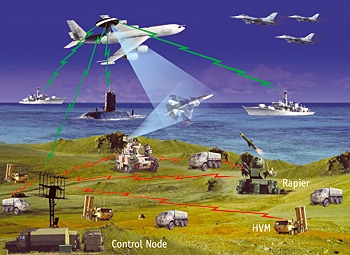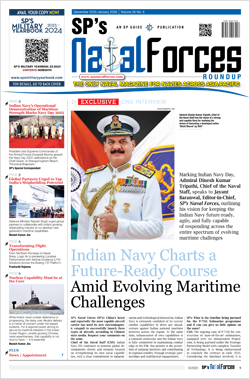INDIAN ARMED FORCES CHIEFS ON OUR RELENTLESS AND FOCUSED PUBLISHING EFFORTS

The insightful articles, inspiring narrations and analytical perspectives presented by the Editorial Team, establish an alluring connect with the reader. My compliments and best wishes to SP Guide Publications.

"Over the past 60 years, the growth of SP Guide Publications has mirrored the rising stature of Indian Navy. Its well-researched and informative magazines on Defence and Aerospace sector have served to shape an educated opinion of our military personnel, policy makers and the public alike. I wish SP's Publication team continued success, fair winds and following seas in all future endeavour!"

Since, its inception in 1964, SP Guide Publications has consistently demonstrated commitment to high-quality journalism in the aerospace and defence sectors, earning a well-deserved reputation as Asia's largest media house in this domain. I wish SP Guide Publications continued success in its pursuit of excellence.
- Global Partners Urged to Tap India's Shipbuilding Potential: Rajnath Singh at Samudra Utkarsh
- All about HAMMER Smart Precision Guided Weapon in India — “BEL-Safran Collaboration”
- India, Germany deepen defence ties as High Defence Committee charts ambitious plan
- G20 Summit: A Sign of Global Fracture
- True strategic autonomy will come only when our code is as indigenous as our hardware: Rajnath Singh
- India–Israel Joint Working Group Meeting on defence cooperation to boost technology sharing and co-development
Technology
Net-Centricity to Ne(x)t-Centricity

The time has come to ask questions about how to deliver tangible benefits in the context of network-centric operations. These are not technology-related questions but questions about employment of security forces in a network-centric paradigm as opposed to the platform-centric paradigm that they have historically engaged in.
“Network-centric warfare is not only about networks, but also about how wars are fought— how power is developed.”
—Vice admiral (retd) Arthur K. Cebrowski
The Need for Network-Centric Operations (NCO) is obvious and so is the fact that giant steps have been taken by security establishments across the country in the past decade to bring this capability to the table. There also is an increasing realisation that the challenges remain, and the road ahead may not be as easy as initially thought. Much of the writing and comments available in the public domain has gravitated towards technological challenges. But as global organisations continue their endeavours to overcome these challenges, they must not confuse the means with the end.
This article argues that the time has come to ask questions about how to deliver tangible benefits in the context of NCO. These are not technology-related questions but questions about employment of security forces in a network-centric paradigm as opposed to the platform-centric paradigm that they have historically engaged in. such incremental thinking on operational matters, until the desired capabilities are realised, will also help avoid failures in the field, given the critical importance of military IT systems. This approach also will lead to better end products that are relevant and efficient for the operational community. In other words, thinking and further courses of action must evolve from being merely netcentric to becoming ne(x)t-centric.
The issues that need to be dealt with in this context are as follows:
Conceptual framework: The first step in NCO implementation is to develop a conceptual framework that runs across the NCO domains within a service and in the joint contexts. This would lead to identifying metrics that provide objectivity to the tenets and hypotheses that have been presumed when setting off on the NCO path. Field observations, exercises, war-gaming, case studies across missions and tasks, and experimentation tailored to NCO should then be conducted to help investment decisions and priorities, fine-tune concepts of operations and perhaps direct further research and development. The insights arising from such endeavours will help developers refine the NCO end product.
Operational roadmap: Beyond the doctrine, work on developing and codifying NCO operational theory must be started as soon as possible. There must be a clear roadmap for adjusting and refining operational concepts and theory as NCO systems and capabilities are implemented. Operational implementation and usage of NCO-delivered capabilities must thus be completed in phases that are concurrent with technology implementation. This also will help users detect and avoid pitfalls in the early days, leading to more efficient technology development. Because the ultimate vision is to undertake net-centric operations jointly, such operational checkpoints can save considerable confusion and even failures, later. In other words, implementation of technology, conduct of NCO, and testing the evolved theory of operations cannot be done in one big bang. Given that field deployment of NCO is still in the early stages, this is best done in simulated wargaming and experimentation environments. even if the system characteristics are nebulous in the early stages of NCO development, as has been observed in many analysis and experimentation labs, the insights that can be gained help avoid many tradeoffs and adjustments that occur later.
The fourth domain: Initial constructs envisaged NCO components and aspects within the physical, information and cognitive domains. The cognitive domain encompasses perceptions, beliefs, leadership, and doctrines. The need to include a fourth domain, the social domain, arose later, when it was understood that individuals have distinct perceptions of phenomena or information. In turn, individual perceptions play out differently in interactive situations such as collaborative decision-making, especially when individuals come from different social backgrounds. While nationality, language, culture, and education are relevant social aspects in this context, organisational affiliations and culture also play very significant roles in a networked environment. As the network grows and encompasses different agencies and organisations, information usage and the actions that follow will certainly be affected in many ways due to such social factors. Though some work has been done, sustained and rigorous studies to identify issues, find ways to deal with them and provide training is essential.
Management of change: Individuals’ skills, their roles, how they are organised and led, and how they fight evolve over lifetimes. even when a technology is implemented successfully, usage and adoption can be a significant challenge. early in the NCO technology induction phase, therefore, concerted efforts must be made to prepare individuals and teams. This readiness must not only be in terms of maintenance, upkeep and network security, but also in terms of operational usage and exploitation. Given the short timeframes in which information technology leapfrogs from one level to another, the earlier the individuals get to upgrade their skills, the better. Otherwise there is always the danger that even the most enabling technologies are rejected due to cultural rather than technical reasons. The new generation of end users may be quicker on their feet in this respect, and so greater attention must be paid to those who may be more suspicious of new technology and processes. Similarly, the organisational structures and leadership changes that NCO demands must not be limited to the horizontal versus vertical debates, as the truth lies somewhere in the middle.





